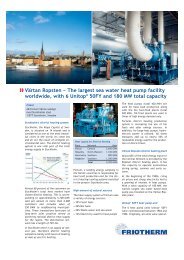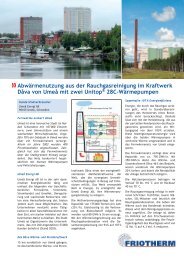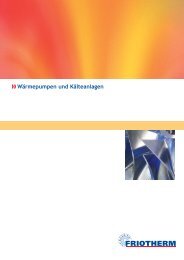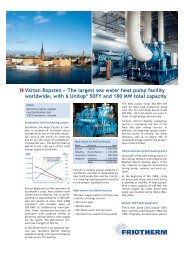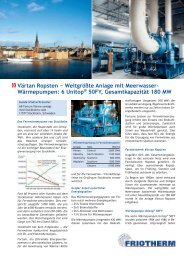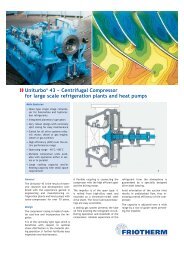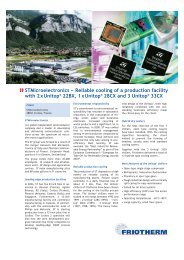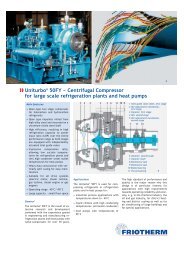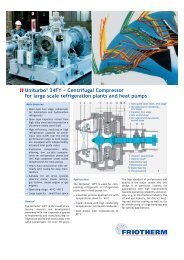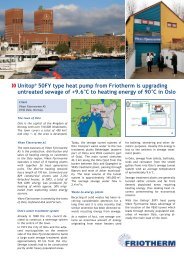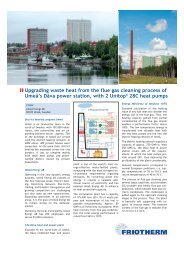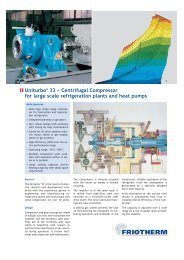5 Unitop® 50FY heat pump / chiller units simultaneously ... - Friotherm
5 Unitop® 50FY heat pump / chiller units simultaneously ... - Friotherm
5 Unitop® 50FY heat pump / chiller units simultaneously ... - Friotherm
You also want an ePaper? Increase the reach of your titles
YUMPU automatically turns print PDFs into web optimized ePapers that Google loves.
designed with loops allowing distribution<br />
to customers via several alternative<br />
routes, if required. Looped networks<br />
increase distribution reliability<br />
considerably.<br />
The operation of Helsinki Energy’s<br />
district <strong>heat</strong>ing network is constantly<br />
monitored, limiting interruptions to a<br />
minimum.<br />
...and district cooling<br />
Since the late 1990s, Helsinki Energy is<br />
also constantly developing its district<br />
cooling system.<br />
One of the main reasons for the growing<br />
popularity of district cooling is<br />
seen in the increased concentration on<br />
core business activities of companies<br />
and subsequent outsourcing of building<br />
services. Another reason for the growing<br />
popularity of the service is its environmental<br />
friendliness and cost-effectiveness<br />
compared to conventional<br />
technology with local installed small<br />
air conditioning <strong>units</strong>.<br />
From Helsinki Energy’s point of view,<br />
district cooling also enhances the energy<br />
efficiency of CHP production even<br />
further. Along with electricity and district<br />
<strong>heat</strong> sales, district cooling constitutes<br />
a new form of energy service.<br />
Development of district cooling<br />
The capacity of the first district cooling<br />
plant located at the Salmisaari<br />
power plant is 10 MW. It consists of<br />
two absorption <strong>chiller</strong>s and a 1,000 m 3<br />
chilled water storage tank to cope with<br />
peak loads. Between the years<br />
2002-2006 another district cooling<br />
plant was built in the Salmisaari power<br />
plant area. The total capacity of this<br />
plant is 28 MW.<br />
The chilled water is distributed via the<br />
underground district cooling network<br />
to office and business buildings connected<br />
in the district of Ruoholahti.<br />
Since the year 2002, district cooling<br />
has been supplied to office buildings<br />
in the district of Hermanni and Vallila.<br />
Transportable cooling <strong>units</strong> produce<br />
the required cooling energy until a<br />
cooling plant and corresponding distribution<br />
network for district cooling are<br />
constructed in the area.<br />
Energy distribution tunnels<br />
Helsinki Energy operates close to 30 km<br />
of multi-utility tunnels excavated in<br />
bedrock. They contain water-, district<br />
<strong>heat</strong>ing- and district cooling pipelines,<br />
electric cables up to 110 kV as well as<br />
electric and telecommunication cables<br />
for domestic purposes. The size of the<br />
tunnels allows travelling by car.<br />
Due to the growing demand, Helsinki<br />
Energy has increased its district cooling<br />
production capacity significantly<br />
with the new Katri Vala installation.<br />
A distribution network is built to connect<br />
the city centre of Helsinki and the<br />
district of Sörnäinen to the new plant.<br />
Katri Vala combined district <strong>heat</strong>ing<br />
and district cooling plant<br />
In a rock cavern excavated beneath<br />
the Katri Vala Park in the Sörnäinen<br />
district of Helsinki, the <strong>heat</strong>-<strong>pump</strong><br />
plant is generating district <strong>heat</strong> of<br />
88ºC and <strong>simultaneously</strong> chilled water<br />
with a temperature of 4ºC for district<br />
cooling purposes.<br />
5 6<br />
Excavation work for the installation<br />
started in summer 2004 and the plant<br />
has been in commercial operation<br />
since autumn 2006.<br />
The Katri Vala installation is connected<br />
to the Suvilahti seawater <strong>pump</strong>ing<br />
station via a 600 m long multi-utility<br />
tunnel.<br />
“First, the seawater <strong>pump</strong>ing station<br />
will only serve the Katri Vala <strong>heat</strong><strong>pump</strong><br />
plant. By 2020, the <strong>pump</strong>ing station<br />
will also serve the future Suvilahti<br />
and Pasila district cooling plants” says<br />
Mr Veijo Noponen, who is a process<br />
designer and installation supervisor at<br />
Helen Engineering, a business unit of<br />
Helsinki Energy.<br />
4



